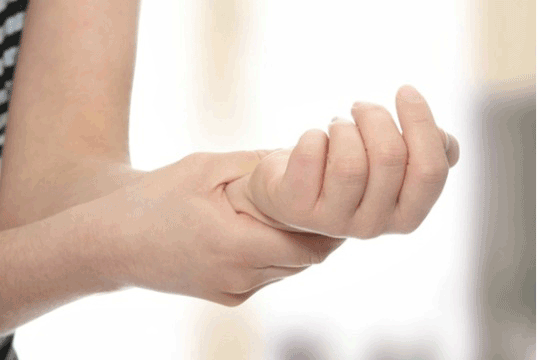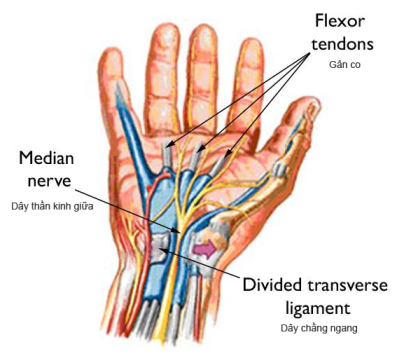News - Tue, 03/27/2018 - 16:05
Carpal Tunnel Syndrome
Last update 09/27/2024 - 17:58

What is carpal tunnel syndrome (CTS) and what are the symptoms?
CTS is caused by pressure on the median nerve, which runs the length of the arm to the hand, whilst travelling through the wrist passage called the carpal tunnel.
The median nerve controls the movements and sensations of your thumb and other fingers, except the pinky. If the median nerve is compressed you may feel numbness, tingling, pain or weakness in your hand and the first four fingers.
Symptoms generally start at night, as most people sleep with their wrists bent increasing the pressure on the median nerve. As the condition worsens, you may experience the same symptoms during the day usually associated with actions that make your wrist bend up or down for some time, like typing on your computer or driving your car or any other repetitive motion.
Diagnosis?
Your doctor may do several tests to diagnose CTS and rule out other causes for your symptoms, which commonly include:
- Physical examination to test the feeling in your fingers and the strength of your hand muscles. Bending the wrist, tapping on the nerve or simply pressing on the nerve may trigger symptoms.
- X-ray.
- Nerve conduction study (NCS) & Electromyogram (EMG). A NCS measures the speed for a nerve impulse to travel along a nerve and how your muscles respond to the signal. If the nerve is trapped, damaged or diseased then these signals will be slower and your muscular response less. During a needle EMG the electrical activity of your muscles are measured at rest and after muscle contraction, which is directly recorded by inserting a small needle electrode into your muscle(s). This is sometimes necessary in addition to the NCS to confirm the diagnosis of CTS and rule out other conditions.

Treatment of carpal tunnel syndrome?
CTS starts off slowly but worsens progressively. It is important to start treatment as early as possible to minimize the risk of permanent nerve damage and to maximize outcome and ensure a speedy recovery. A number of options are currently available.
If you have moderate symptoms for less than six months or when awaiting surgery, non-surgical treatment may help to relieve your symptoms. Such options include:
- Wrist splinting to stabilize your wrist during sleep time which may improve nighttime symptoms and are a good solution during pregnancy.
- Non-steroidal anti-inflammatory drugs may help to relieve pain but cannot improve the cause, they should only be used for short term periods.
- Corticosteroid injections into the carpal tunnel may decrease inflammation and swelling and consequently pressure on the median nerve and pain. This treatment usually only has short term effects.
If your symptoms are severe, have lasted for more than six months or do not respond to other treatment, surgical treatment may be the answer for you. Surgical treatment of CTS is considered the gold standard yielding excellent immediate and long-term results. Two different techniques are available, endoscopic and open surgery. During both your surgeon cuts the ligament around the carpal tunnel to reduce the pressure on the median nerve. The ligament will heal back together but with more space for the nerve.
- Open surgery involves a larger cut or incision on your palm of your hand over the carpal tunnel through the ligament to free the nerve, your surgeon may also remove synovial tissue if you have an inflammation of your flexor tendons- tendinitis- often associated with CTS.
- In endoscopic surgery, your surgeon makes two small openings in your wrist and hand and inserts a telescope-like device with a tiny camera attached to it (endoscope) to see inside the carpal tunnel and to guide him when he cuts the ligament. Because the openings a smaller with this technique, you may heal faster and have less pain.
With either technique, only short stay hospitalization is required. Based on the severity of your condition, your surgeon will recommend the type surgery and anesthesia most suitable for you. Your doctor will also explain the risks and benefits associated with the recommended procedure. Complications are rare, ask your doctor for detailed explanations about the risks which may include nerve damage, wound infection and a painful scar. Sometimes the ligament is too hard to cut during endoscopic procedure and a conversion to open surgery may be needed. You may experience relief from symptoms the same day of your procedure, but complete healing can take up to several months.
Dr Alain Fauvy works together with Dr. Cao Manh Lieu at the Department of Orthopedic Surgery and Traumatology at HFH and has brought with him his long term expertise in the treatment of conditions and injuries of the bones, joints and muscles.
If you have any questions or want to book an appointment with our doctors, please contact us at our phone number : (84-24) 3577 1100 or send us an inquiry here



